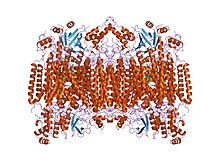- Cytochrome c oxidase subunit III
-
Cytochrome c oxidase subunit III 
Structure of the 13-subunit oxidized cytochrome c oxidase.[1] Identifiers Symbol COX3 Pfam PF00510 InterPro IPR000298 PROSITE PDOC50253 SCOP 1occ TCDB 3.D.4 OPM family 4 OPM protein 1v55 Available protein structures: Pfam structures PDB RCSB PDB; PDBe PDBsum structure summary Cytochrome c oxidase subunit III is one of main transmembrane subunits of cytochrome c oxidase
Cytochrome c oxidase (EC 1.9.3.1) is the terminal enzyme of the respiratory chain of mitochondria and many aerobic bacteria. It catalyzes the transfer of electrons from reduced cytochrome c to molecular oxygen:
- 4 cytochrome c+2 + 4 H+ + O2
 4 cytochrome c+3 + 2 H2O
4 cytochrome c+3 + 2 H2O
This reaction is coupled to the pumping of four additional protons across the mitochondrial or bacterial membrane[2][3].
Cytochrome c oxidase is an oligomeric enzymatic complex that is located in the mitochondrial inner membrane of eukaryotes and in the plasma membrane of aerobic prokaryotes. The core structure of prokaryotic and eukaryotic cytochrome c oxidase contains three common subunits, I, II and III. In prokaryotes, subunits I and III can be fused and a fourth subunit is sometimes found, whereas in eukaryotes there are a variable number of additional small subunits[4].
As the bacterial respiratory systems are branched, they have a number of distinct terminal oxidases, rather than the single cytochrome c oxidase present in the eukaryotic mitochondrial systems. Although the cytochrome o oxidases do not catalyze the cytochrome c but the quinol (ubiquinol) oxidation they belong to the same haem-copper oxidase superfamily as cytochrome c oxidases. Members of this family share sequence similarities in all three core subunits: subunit I is the most conserved subunit, whereas subunit II is the least conserved[5][6][7].
Contents
Subfamilies
- Cytochrome o ubiquinol oxidase, subunit III IPR014206
- Cytochrome aa3 quinol oxidase, subunit III IPR014246
Examples
Human genes encoding proteins containing this domain include: MT-CO3
References
- ^ Miki K, Sogabe S, Uno A et al. (May 1994). "Application of an automatic molecular-replacement procedure to crystal structure analysis of cytochrome c2 from Rhodopseudomonas viridis". Acta Crystallogr. D Biol. Crystallogr. 50 (Pt 3): 271–5. doi:10.1107/S0907444993013952. PMID 15299438.
- ^ Michel H (1999). "Cytochrome c oxidase: catalytic cycle and mechanisms of proton pumping--a discussion". Biochemistry 38 (46): 15129–15140. doi:10.1021/bi9910934. PMID 10563795.
- ^ Wikstrom M, Belevich I, Verkhovsky MI (2006). "Proton-coupled electron transfer drives the proton pump of cytochrome c oxidase". Nature 440 (7085): 829–32. doi:10.1038/nature04619. PMID 16598262.
- ^ Mather MW, Springer P, Hensel S, Buse G, Fee JA (1993). "Cytochrome oxidase genes from Thermus thermophilus. Nucleotide sequence of the fused gene and analysis of the deduced primary structures for subunits I and III of cytochrome caa3". J. Biol. Chem. 268 (8): 5395–5408. PMID 8383670.
- ^ Danchin A, Glaser P, Kunst F, Rapoport G, Santana M, Hullo MF (1992). "Molecular cloning, sequencing, and physiological characterization of the qox operon from Bacillus subtilis encoding the aa3-600 quinol oxidase". J. Biol. Chem. 267 (15): 10225–10231. PMID 1316894.
- ^ Lemieux L, Gennis RB, Chepuri V, Au DC (1990). "The sequence of the cyo operon indicates substantial structural similarities between the cytochrome o ubiquinol oxidase of Escherichia coli and the aa3-type family of cytochrome c oxidases". J. Biol. Chem. 265 (19): 11185–11192. PMID 2162835.
- ^ Rumbley J, Gennis RB, Garcia-Horsman JA, Barquera B, Ma J (1994). "The superfamily of heme-copper respiratory oxidases". J. Bacteriol. 176 (18): 5587–5600. PMC 196760. PMID 8083153. http://www.pubmedcentral.nih.gov/articlerender.fcgi?tool=pmcentrez&artid=196760.
Further reading
The whole structure of the 13-subunit oxidized cytochrome c oxidase at 2.8 A. Tsukihara T, Aoyama H, Yamashita E, Tomizaki T, Yamaguchi H, Shinzawa-Itoh K, Nakashima R, Yaono R, Yoshikawa S; Science 1996;272:1136-1144. PubMed

This membrane protein-related article is a stub. You can help Wikipedia by expanding it. - 4 cytochrome c+2 + 4 H+ + O2
